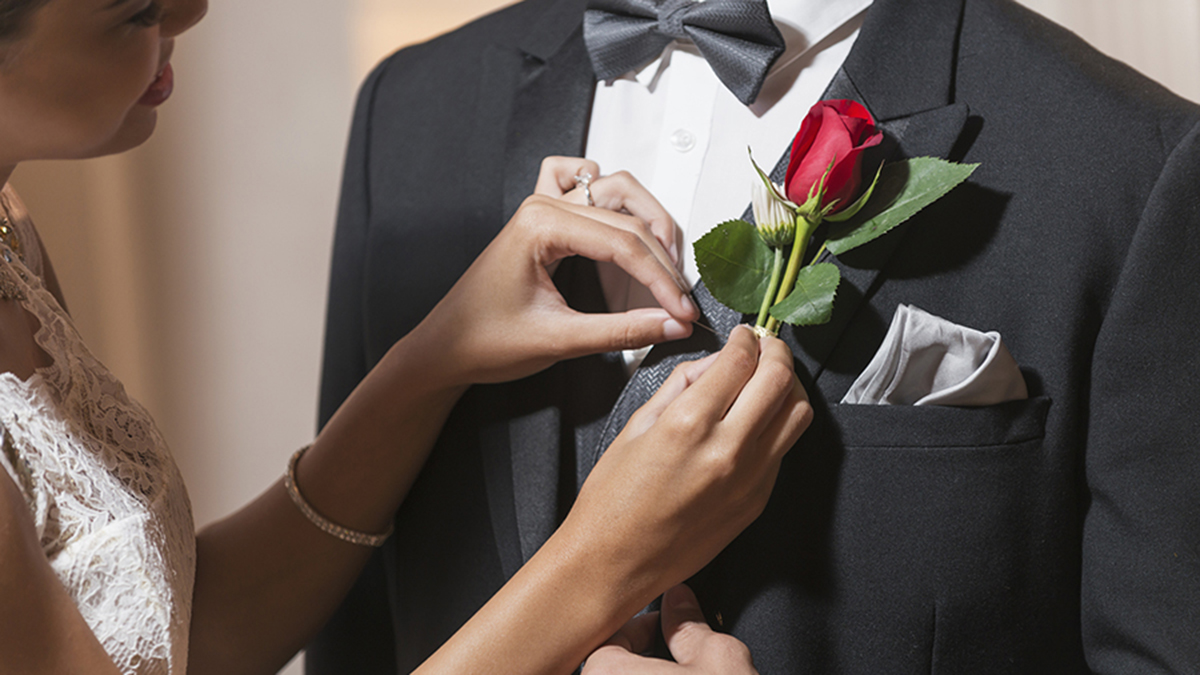The Corsage and Boutonniere: A Floral History
Learn more about these two formal floral accessories that typically grace high school dances and wedding.
May 12, 2022
Throughout history, whenever people dressed for a formal event, flowers were always an important part of the outfit. Formalwear demanded floral accessories. And the two most popular items adorning outfits were corsages and boutonnieres.
Today, flowers on dresses, lapels, wrists, and hair are popular, especially at high school proms and weddings, according to Jackie Lacey, a member of the Professional Floral Commentators International and the 2019-2021 National President of the American Institute of Floral Designers. Floral accouterments are fashion statements, Lacey says, just as much as wearing jewelry or accessorizing with scarves, gloves, and bags.
The practice of wearing flowers as decoration goes back thousands of years.
History of corsages
Traditionally, a corsage was a small bouquet pinned to a dress. Ancient Greeks believed fragrant flowers warded off evil spirits, which explains why brides carried bouquets down the aisle or pinned flowers to themselves.
Derived from the French words “bouquet de corsage," which translates to “bouquet of the bodice," corsages originally were worn by French women to weddings and funerals, and were most often pinned to the top of their dresses.
In the Victorian era, women started putting flowers in their décolletage, the low-cut neckline of their dress. “One of the reasons corsages were moved to the shoulder was because the suitor, if he brought her one, would never touch a woman in that area of her body," Lacey says. "So they were moved to the shoulder, where he could pin it appropriately."

The 21st century ushered in sleeveless and spaghetti-strap dresses, and that led to corsages making their way from women's chests to their wrists.
We typically think of corsages and boutonnieres as popping up around prom season. But corsages used to show up at church and brunch on holidays such as Easter and Mother's Day. “Corsages were worn for Easter as part of new clothes. They became a fashion accessory that you would wear," Lacey says.
While corsages used to be a symbol of romantic love, they've become more of a fashion statement in recent years. Today, it's not uncommon for parents to buy a corsage for their daughter, friends to buy them for one another, and even people to buy them as gifts for themselves.
History of boutonnieres
The boutonniere dates back to the ancient Egyptians and Aztecs, who wore flowers to indicate which team or player they supported in sporting events, Lacey says.
In the 15th century, a woman who was interested in a knight might give him flowers or a scarf in the color of the dress she was wearing on his foray into battle, Lacey says. The gesture meant good luck and bestowed her good graces on the knight.
Lacey points to the Wars of the Roses, when the Lancaster family wore red and the York family white as part of their coat of armor, as a key point in the history of boutonnieres.

“Flowers were worn to show support to one side of a battle over the other because the speech and clothing would have likely been the same," he says. The English wars for power were the gateway to men wearing flowers or boutonnieres.
The rise of men wearing boutonnieres, or lapel adornments, grew in the early 19th century, when the period dress began to include coats that folded over at the top and included a buttonhole, Lacey says. “Many men would wear flowers every day as part of their daily clothing since most men in business wore a suit to work," he adds.
As recently as 20 years ago, boutonnieres could be observed on the suits — typically on the left side, where the lapel buttonhole is — of men on Mother's Day, Lacey found. “There used to be a huge market of flowers in white or red to indicate whether or not your mother was alive," he says. White meant she was living, and red meant she was not.
The boutonniere became a key element of a promgoers' attire, although they did go out of style for a few years, starting around 2012. “Young people, for a little while, felt the flowers were passé, an extra expense, and a luxury they could do without," Lacey says. Sales of prom flowers are back today, with young people choosing to express themselves with their flower choices, and that is partly because of creativity in the industry. "Some of the increase was due to flower shops rethinking the way they market to this generation and how to recapture declining sales," he says.
Today, boutonnieres also are often seen on the lapel of a groom and other members of his bridal party at his wedding, with the women carrying corresponding bouquets of flowers. The sophisticate may occasionally wear a boutonniere at a special event such as an auction or a fundraising party. A flower on the lapel is also a mark of significance on special occasions. "Wearing a boutonniere might show you are being honored or of importance to the event," Lacey says.
The history and tradition of corsages and boutonnieres is surprisingly rich and eclectic. If you're a promgoer this year, or if someone close to you is, you're now equipped with all you need to know to choose the perfect flowers for the big night.







